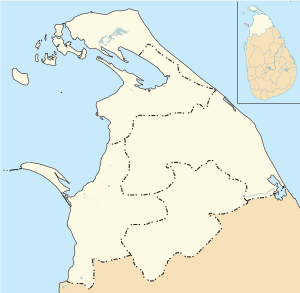Arippu Fort (Tamil: அரிப்புக் கோட்டை, romanized: Arippuk Kōṭṭai; Sinhala: අරිප්පු බලකොටුව, romanized: Arippu Balakotuwa; also known as Allirani fort;[1] Tamil: அல்லிராணிக் கோட்டை, romanized: Allirāṇik Kōṭṭai) was built by the Portuguese and was handed over to the Dutch in 1658.[2] The small bastion fort is located in Arippu, which is 16 km (9.9 mi) away from Mannar Island. The fort is nearly square in shape, with two bastions.
| Arippu Fort | |
|---|---|
| Mannar, Sri Lanka | |
| Coordinates | 8°47′33″N 79°55′47″E / 8.792592°N 79.929653°E |
| Type | Defence fort |
| Site information | |
| Condition | Ruins |
| Site history | |
| Built by | Portuguese |
| Materials | Brick |
Robert Knox, English sea captain and famous British prisoner of the Kandyan King Rajasinghe II, and his companion escaped after nineteen years of captivity and reached the Arippu Fort in 1679.[3]
The first British Governor of Ceylon, Frederick North, constructed his official summer residence at the beach front, now known as The Doric and converted the fort into accommodation for the officers, who operated the pearl fisheries in the area. The fort building was subsequently converted to a guest house but was abandoned when the civil war spread to the area.
A legend says the Tamil Queen Alli Raani ruled in Mannar region. It believes that her fortress was located where the ruins of fort can be seen today.[4][5] Further, the legend says that Kudiramalai area was her palace,[6] and Queen Alli ruled where Kuveni subsequently ruled.[7] There is no archeological evidence of the existence of the queen.[8]
References edit
- ^ "Allirani Fort". Ministry of Public Administration & Home Affairs. Retrieved 18 July 2015.
- ^ "Arippu Fort". Retrieved 9 November 2014.
- ^ "An ancient village, a ruin by the sea and stories of pearls from Taprobane". Retrieved 9 November 2014.
- ^ "Maha Vishnu's Temple Maha Kumbabheshekam". Daily News (Sri Lanka). Retrieved 18 July 2015.
- ^ Kulendiren, Pon (2012). Hinduism a Scientific Religion: & Some Temples in Sri Lanka. iUniverse. p. 212. ISBN 978-1-4759-3673-5.
- ^ "The jewel of the deep". Sunday Times (Sri Lanka). Retrieved 18 July 2015.
- ^ "The Sinhalese of Ceylon and The Aryan Theory". Retrieved 18 July 2015.
- ^ Wisumperuma, Dhanesh (2005). "The Doric at Arippu: Its Date and Identification". Journal of the Royal Asiatic Society of Sri Lanka. 51 (New Series): 79–96. Retrieved 18 December 2023.
- Nelson, W. A.; de Silva, R. K. (2004). The Dutch Forts of Sri Lanka – The Military Monuments of Ceylon. Sri Lanka Netherlands Association.
